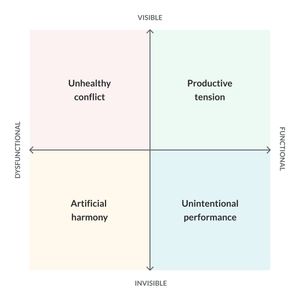Many teams (at work and at home) struggle with conflict – having too much, too little, or the wrong kind.
At The Ally Co., we've been observing and thinking a lot about conflict in the workplace – specifically when it comes to team interactions and relationships. While systemic forces are always at play, these days it can seem like tension and conflict are more frequent and intense than ever.
So we thought it might be meaningful to break down conflict, and explore the gifts that can come from shifting our perspectives and approaches to it when it comes to our relationships.
Framing conflict
Jayson Gaddis, author of Getting to zero: how to work through conflict in your high-stakes relationships, writes that "conflict is usually the result of either too much closeness or too much distance". This aligns with our experience in working with teams where conflict can arise from competing needs, values, and goals – at the individual and collective levels.
When most people hear (or see) the word 'conflict', they tend to think of aggression, violence, and war. But what about the other side of the spectrum? What if instead of approaching conflict from an 'at-risk' place (e.g. what we have to lose from it), we choose to approach it from an 'at-stake' perspective (e.g. what we have to gain from it)?
What might we discover about ourselves and others? What might we accomplish? And how might we feel with this reframe?
Assessing conflict
We'd like to introduce you to a framework we're developing to help teams assess and identify where they may 'be' when it comes to the different ways they are experiencing conflict. In other words, this is a framework to help teams raise their individual and collective awareness, so that they can start to meaningfully transform their conflict into positive outcomes.

Conflict visibility
Let's review some examples of team conflict and explore what we mean when it’s visible and/or invisible. Conflict is visible when the people on a team can see, hear, and feel it (i.e. it has been surfaced and the team is aware of it). For example, conflict might show up as one-time or recurring arguments during meetings, disagreements on social media (both internally and externally), or fiery emails where everyone is cc'd.
When conflict is invisible, it doesn't mean that it cannot be seen, heard, or felt. Instead, it means that the collective team might not all individually be aware of it or any tension that exists. For example, only one or a few people may be experiencing it. At the individual level, a team member might be 'going home' every night and bringing frustration and anger into their other relationships; or they might be suffering in silence (slowly distancing themselves from their loved ones).
Conflict functionality
When team conflict is functional, it's helping to create meaningful, positive impact. It's being used to create value for the team - deeper connections, stronger collaboration, better innovation and performance, etc. In other words, in this situation conflict is a valuable tool and indicator of a strong culture and relationship(s).
When conflict is dysfunctional, it can be harmful and create negative impact. For example, it could be leading to issues such as aggression, silos, and even trauma. Dysfunctional conflict is unhealthy and leads to a range of common problems in the workplace like employee disengagement, high levels of stress and burnout, grievances, and poor customer experiences.
Four (4) types of conflict
1. Unhealthy conflict
Following our framework, unhealthy conflict is both visible and dysfunctional. In our work with teams, a few recent examples of this include two leaders battling it out with their respective teams cc'd on email, a leader yelling at a subordinate in their warehouse, and a board member back-channeling their personal feedback about a leader to that leader's peer. In the latter example, that leader found out about it, which made it visible and dysfunctional.
2. Artificial harmony
While artificial harmony is less visible to invisible in some cases, the level of harm it can lead to can be equally profound as unhealthy conflict (and in some cases even more so). In fact, we notice higher levels of artificial harmony on teams that have positive external brand identities. People don't want to 'rock the boat' in fear of not seeming grateful, being passed up on a promotion, or being alienated.
Artificial harmony can show up on a team as 'stuck-ness' - unproductive meetings, missed deadlines, minimal accountability, unclear ownership. People avoid difficult/meaningful conversations, there is a lack of healthy and vigorous debate - no one contributing or challenging decisions or actions, or unexpected turnover. Another signal of artificial harmony is informal meetings and backchannel decision-making between individuals or small groups - before or after the formal meetings, usually to build alliances or debrief the experience.
Self-care expert and professional coach Cheryl Richardson explains the impact of artificial harmony when she writes "if you avoid conflict to keep the peace, you start a war inside yourself". We'd go even further and say that the war inside of you will slowly leak out and negatively impact other parts of - and people in - your life.
3. Unintentional performance
Occasionally, leaders and teams get lucky (not the good kind in the long term). Unintentional performance usually shows up in pockets or on specific teams. Since there is a low (and sometimes non-existent) sense of awareness, the organization struggles to replicate or operationalize this performance in other parts of the business.
In our experience, unintentional performance often occurs when there are strong personal characters on a team - e.g. people who are willing to lean into discomfort and navigate tension as it arises. Organizations who spend time understanding the drivers of this type of conflict, can benefit greatly from codifying and structuring what they learn - moving from unintentional to intentional and proactive performance.
4. Productive tension
The last type of conflict is what the highest-functioning and top-performing teams are doing. On these teams, conflict is surfaced (made visible) and used in functional and meaningful ways. These teams tend to have high levels of awareness, skill and competency, and leadership support/engagement. These teams work through conflict together, and achieve exceptional outcomes such as connection and trust, creativity and innovation, performance and impact.
For teams looking to meaningfully transform the way they are with conflict, this typically involves helping to increase awareness (of self and others), develop key skills and competencies, and design structures and systems that support adaptive capacity.
Parting thoughts
So there you have it. In a world where organizational social responsibility, hybrid work environments, and distributed decision-making are just some of the latest employee expectations, getting to productive tension can be a transformational outcome for teams and organizations.
We hope what we've shared here helps to spark curiosity, understanding, and discussion (productive tension anyone?).
And if your team is wondering where to start, reach out or check out our healthy conflict and productive tension culture survey (or any of our other culture surveys for that matter). Establishing a baseline from the feedback of the people you want to impact can enable you to take meaningful action towards developing high-functioning teams and a fulfilling workplace culture.
